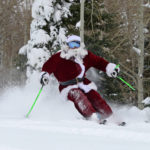Unique Ways to Improve Your Skiing
Practice makes perfect! We’ve all heard this mantra and the reality is that it’s true. There’s quite a bit of data around the concept of countless hours of repetitive process to perfect a skill. In fact it has even been said it takes 10,000 hours to reach a very high level of skill execution. So, what does this mean for skiers who aren’t looking to join the ranks of Olympians? A few helpful tips are sure to help you make improvements in your skiing journey.
SKI:
Yes, the simple fact is that the more you ski the better you will be. Skiing is a unique sport in that the best way to train for skiing is in fact skiing. Novel, I know. But, it’s a good motivation to know that the more time you spend on the slopes, the more comfortable you will be. Skiing is a sensory sport so it’s important to be on the snow so you can have a sense of the movements needed to improve.
VARIED TURNS:
Often we get comfortable and even a bit lazy with our skiing. (Yep me too)
We find ourselves making the same sized turns on groomed runs regardless of the terrain or conditions. So, similar to skiing in the moguls where you are forced to make tempo changes, see if you can challenge yourself to do the same on groomed runs. Make 10 tight slalom style turns or 10 slightly bigger turns. The key is being able to maintain speed and technical control. You can challenge yourself to do an entire run varying turns the whole way down.
PICK A TECHNICAL SKILL TO FOCUS ON:
Technique along with repetition is really the basis for improvement. Olympic caliber athletes are working on the same basic skills that they learned at 10 years old. They are simply working to fine tune and tweak specifics. A few fundamental skills to see if you can hone in on would be pole plant, upper body control and upper and lower body separation.
Pole Plant: This is super important for timing and control. Your pole plant should come at the start of each turn. As you bring your weight up and forward to start you turn you plant your pole, leading into the actual turn itself.
Upper Body Control: You should aim to keep your upper body facing down the hill as your lower body creates the motion of turning. Keeping your shoulders facing down the hill allows your lower body to create to angles and motion needed. Additionally, the more you can focus on keeping your core strong, the easier this task will be.
Upper and Lower Body Separation: This is really a continuation of the previous skill. As you work to keep your upper body (Shoulders and core) facing down the hill, your lower body will create the motion to turn. Often, we think a turn is generated from your upper body or arms. But this is actually a deterrent from a strong turn. A turn is created from your knees and ankles. So try to create a separation from your upper and lower body by recognizing where you are generating a turn from.
As with anything, while you are learning a new skill or trying to perfect old ones give yourself time and grace! Perfection doesn’t come overnight.
Enjoy!
-Caroline



